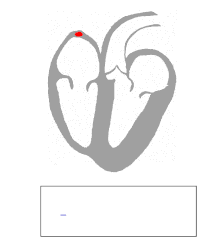Procedures to counter coronary artery disease
- Coronary artery bypass surgery (CABG)
- Grafting an artery or vein from elsewhere (typically the leg) to bypass a stenotic coronary artery.
- Enhanced external counterpulsation (EECP)
- Pneumatically assisting the heart move blood through cuffs on the legs.
- Percutaneous coronary intervention (PCI)
- Procedures to treat stenotic coronary arteries by accessing through a blood vessel.
- Percutaneous Transluminal Coronary Angioplasty (PTCA)
- Enlarging the lumen of a coronary artery by forcibly expanding it with a balloon.
- Atherectomy
- Enlarging the lumen of a coronary artery by removal of atherosclerotic plaque.
- Stenting
- Enlarging the lumen of a coronary artery by forcibly expanding it with a metal wire tube.
Devices used in cardiology
- Stethoscope
- Acoustic device for hearing internal sounds including heart sounds.
- Devices used to maintain normal electrical rhythm
-
- Pacemaker
- An implanted electrical device that replaces the heart's natural pacemaker.
- Defibrillator
- Electrical devices to alter the heart's rhythm with electrical energy.
- Automated external defibrillator (AED)
- An external defibrillator that is commonly found outside of health care settings. Often designed for anyone to use.
- Implantable cardioverter-defibrillator (ICD)
- An implanted device to prevent life-threatening conditions (e.g., ventricular tachycardia, ventricular fibrillation).
- Devices used to maintain blood pressure
-
- Artificial heart
- An internal pump that wholly replaces the pumping action of the heart.
- Cardiopulmonary bypass (CPB) / heart-lung machine
- External pump to take over the function of both the heart and lungs.
- Intra-aortic balloon pump (IABP)
- A balloon placed in the thoracic aorta to supplement cardiac output from the heart.
- Ventricular assist device
- Internal pump to supplement or replace the pumping action of a ventricle.
Diagnostic tests and procedures
Various cardiology diagnostic tests and procedures.
- Blood tests
- Echocardiography ("echo")
- Ultrasonography of the heart to inspect chambers, valves, and blood flow.
- Transthoracic echocardiogram (TTE)
- Echocardiogram of the heart through the thorax external to the body.
- Transesophageal echocardiogram (TEE)
- Echocardiogram of the heart through a catheter placed in the esophagus.
- Cardiovascular magnetic resonance imaging (CMR)
- Magnetic resonance imaging (MRI) of the heart that utilizes the ECG for gating and to look at specific mechanical functions of the heart.
- Cardiac stress test
- Testing of the cardiovascular system through controlled exercise or drugs.
- Auscultation
- Listening to sounds (e.g., heart sounds) with a stethoscope.
- Electrocardiography (ECG or EKG)
- Measurement of the electrical activity of the heart, typically with 4 or 10 electrodes on the skin.
- Holter monitor
- Portable ECG device for continuous monitoring.
- Electrophysiology study
- Studying the electrical activity of the heart through the use of catheters placed in the heart via veins or arteries.
- Sphygmomanometer
- Blood pressure cuff used to measure arterial blood pressure.
- Cardiac marker
- Testing for biomarkers in the blood that may indicate various conditions.
- Coronary catheterization
- Catheterization of the coronary arteries.
- Fractional flow reserve (FFRmyo)
- Testing of the flow through a stenosis of a coronary artery to determine the perfusion of the heart.
- Intravascular ultrasound (IVUS)
- Ultrasonography of a coronary artery.
- Optical coherence tomography (OCT)
- Testing through the use of optical scattering for coronary artery disease.




No comments:
Post a Comment